warning light NISSAN NV PASSENGER VAN 2018 Owners Manual
[x] Cancel search | Manufacturer: NISSAN, Model Year: 2018, Model line: NV PASSENGER VAN, Model: NISSAN NV PASSENGER VAN 2018Pages: 426, PDF Size: 4.52 MB
Page 10 of 426
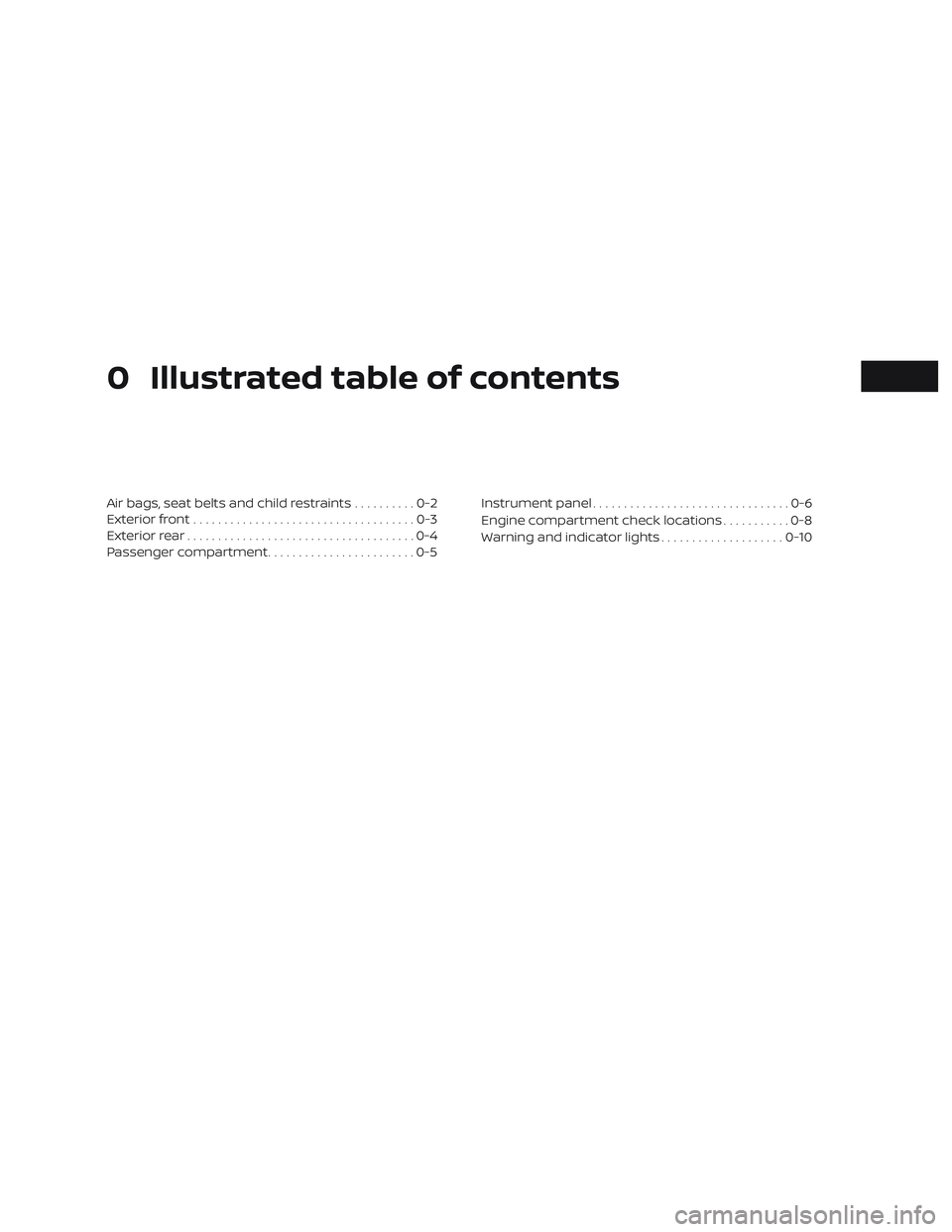
0 Illustrated table of contents
Air bags, seat belts and child restraints..........0-2
Exterior front ....................................0-3
Exterior rear .....................................0-4
Passenger compartment ........................0-5 Instrument panel
................................0-6
Engine compartment check locations ...........0-8
Warning and indicator lights ....................0-10
Page 15 of 426
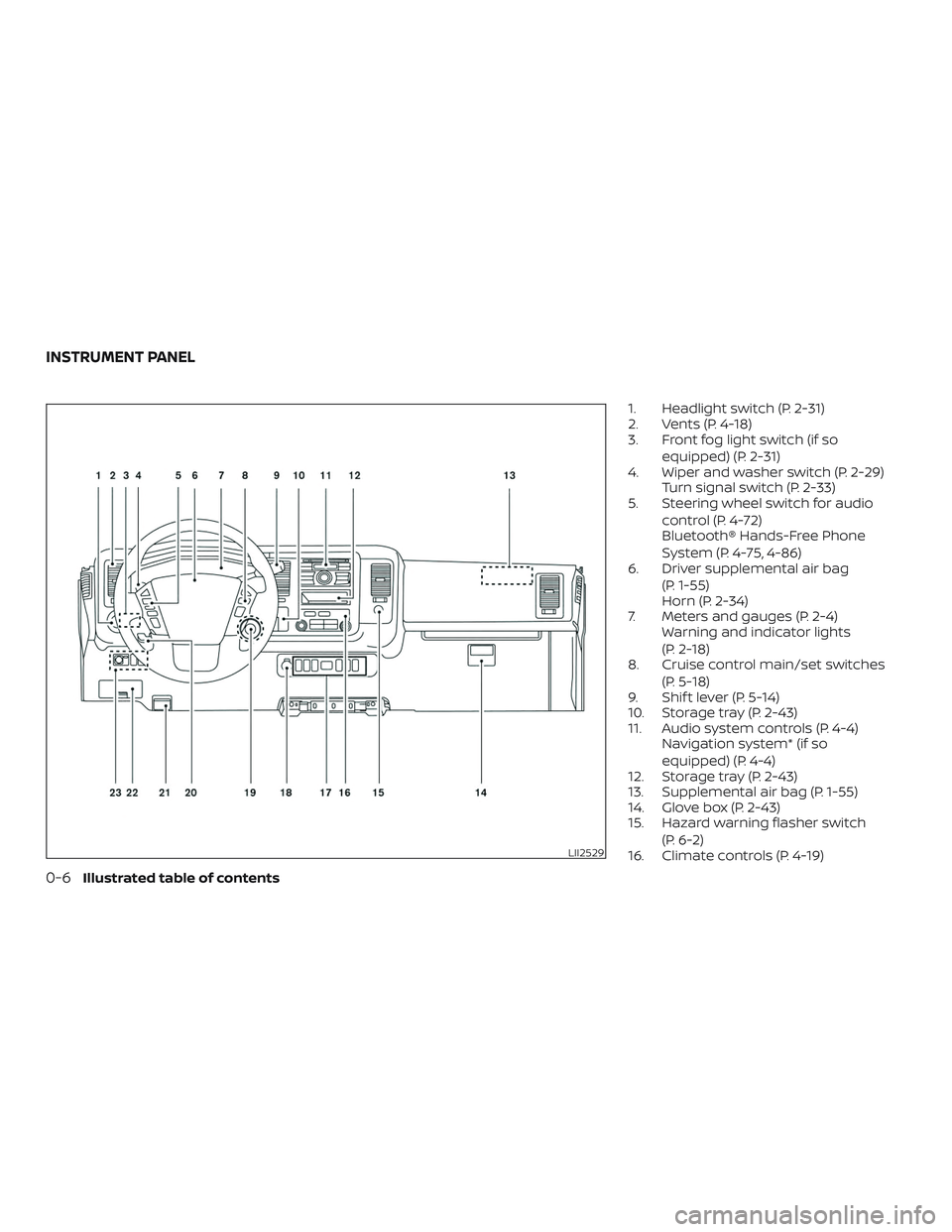
1. Headlight switch (P. 2-31)
2. Vents (P. 4-18)
3. Front fog light switch (if soequipped) (P. 2-31)
4. Wiper and washer switch (P. 2-29) Turn signal switch (P. 2-33)
5. Steering wheel switch for audio
control (P. 4-72)
Bluetooth® Hands-Free Phone
System (P. 4-75, 4-86)
6. Driver supplemental air bag
(P. 1-55)
Horn (P. 2-34)
7. Meters and gauges (P. 2-4) Warning and indicator lights
(P. 2-18)
8. Cruise control main/set switches
(P. 5-18)
9. Shif t lever (P. 5-14)
10. Storage tray (P. 2-43)
11. Audio system controls (P. 4-4) Navigation system* (if so
equipped) (P. 4-4)
12. Storage tray (P. 2-43)
13. Supplemental air bag (P. 1-55)
14. Glove box (P. 2-43)
15. Hazard warning flasher switch
(P. 6-2)
16. Climate controls (P. 4-19)
LII2529
INSTRUMENT PANEL
0-6Illustrated table of contents
Page 19 of 426
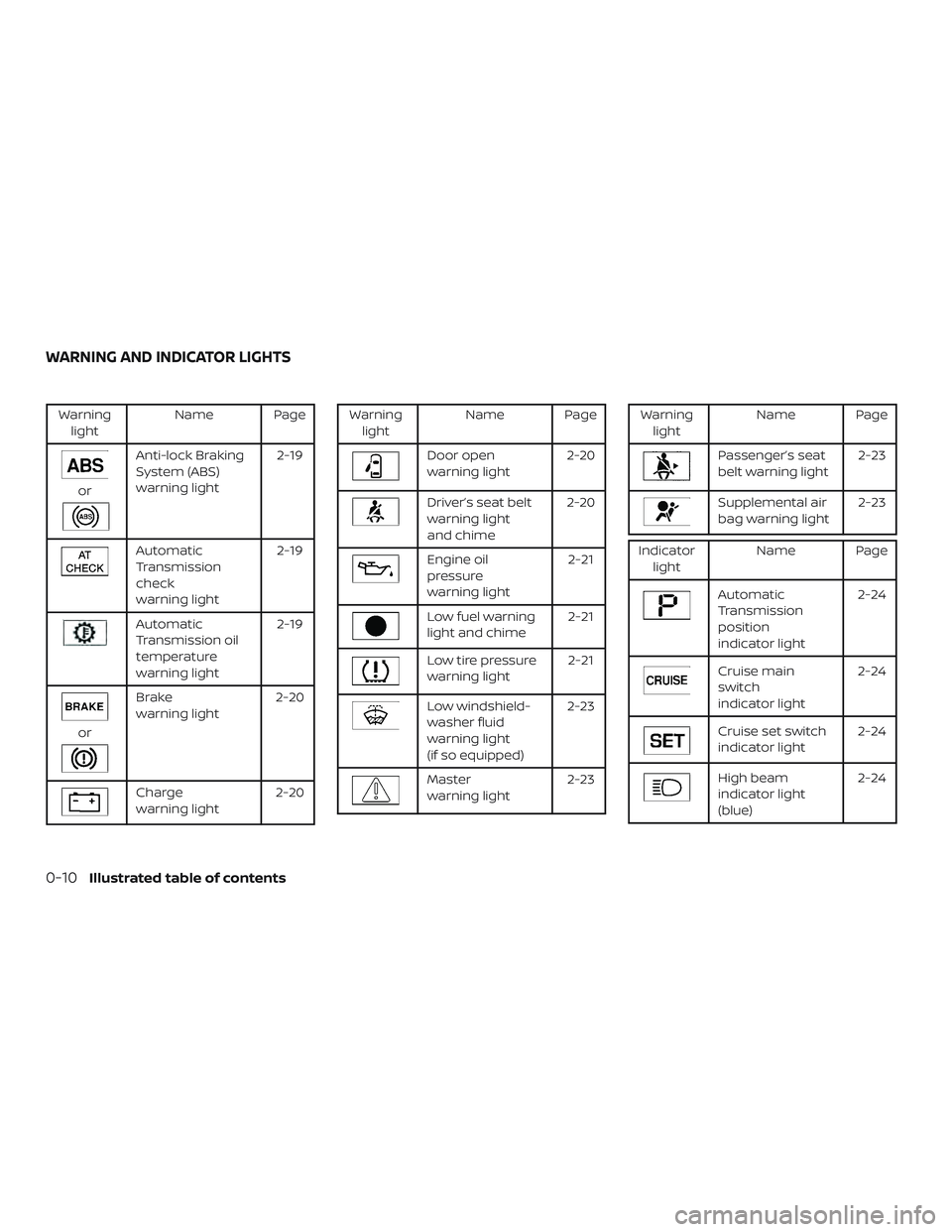
Warninglight Name Page
or
Anti-lock Braking
System (ABS)
warning light 2-19
Automatic
Transmission
check
warning light2-19
Automatic
Transmission oil
temperature
warning light2-19
or
Brake
warning light
2-20
Charge
warning light2-20
Warning
light Name Page
Door open
warning light 2-20
Driver’s seat belt
warning light
and chime2-20
Engine oil
pressure
warning light 2-21
Low fuel warning
light and chime
2-21
Low tire pressure
warning light2-21
Low windshield-
washer fluid
warning light
(if so equipped)2-23
Master
warning light
2-23
Warning
light Name Page
Passenger’s seat
belt warning light 2-23
Supplemental air
bag warning light2-23
Indicator
light Name Page
Automatic
Transmission
position
indicator light 2-24
Cruise main
switch
indicator light
2-24
Cruise set switch
indicator light
2-24
High beam
indicator light
(blue)2-24
WARNING AND INDICATOR LIGHTS
0-10Illustrated table of contents
Page 21 of 426
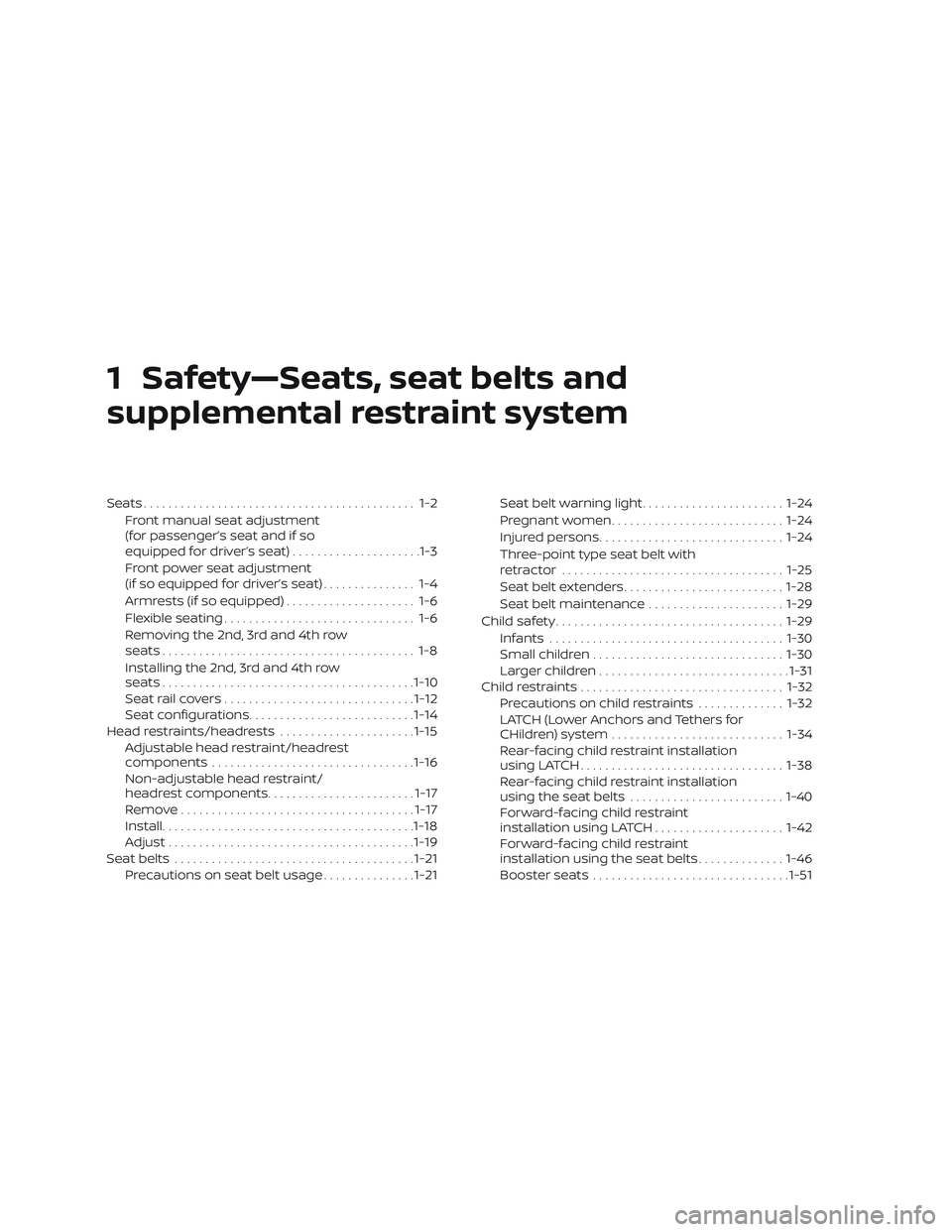
1 Safety—Seats, seat belts and
supplemental restraint system
Seats............................................ 1-2Front manual seat adjustment
(for passenger’s seat and if so
equipped for driver’s seat) .....................1-3
Front power seat adjustment
(if so equipped for driver’s seat) ............... 1-4
Armrests (if so equipped) ..................... 1-6
Flexible seating ............................... 1-6
Removing the 2nd, 3rd and 4th row
seats......................................... 1-8
Installing the 2nd, 3rd and 4th row
seats......................................... 1-10
Seatrailcovers............................... 1-12
Seat configurations ........................... 1-14
Head restraints/headrests ......................1-15
Adjustable head restraint/headrest
components ................................. 1-16
Non-adjustable head restraint/
headrest components ........................ 1-17
Remove...................................... 1-17
Install ......................................... 1-18
Adjust ........................................ 1-19
Seatbelts ....................................... 1-21
Precautions on seat belt usage ...............1-21Seat belt warning light
....................... 1-24
Pregnant women ............................ 1-24
Injured persons .............................. 1-24
Three-point type seat belt with
retractor .................................... 1-25
Seat belt extenders .......................... 1-28
Seat belt maintenance ......................1-29
Child safety ..................................... 1-29
Infants ...................................... 1-30
Small children ............................... 1-30
Larger children ............................... 1-31
Child restraints ................................. 1-32
Precautions on child restraints ..............1-32
LATCH (Lower Anchors and Tethers for
CHildren) system ............................ 1-34
Rear-facing child restraint installation
using LATCH ................................. 1-38
Rear-facing child restraint installation
using the seat belts ......................... 1-40
Forward-facing child restraint
installation using LATCH .....................1-42
Forward-facing child restraint
installation using the seat belts ..............1-46
Booster seats ................................ 1-51
Page 22 of 426
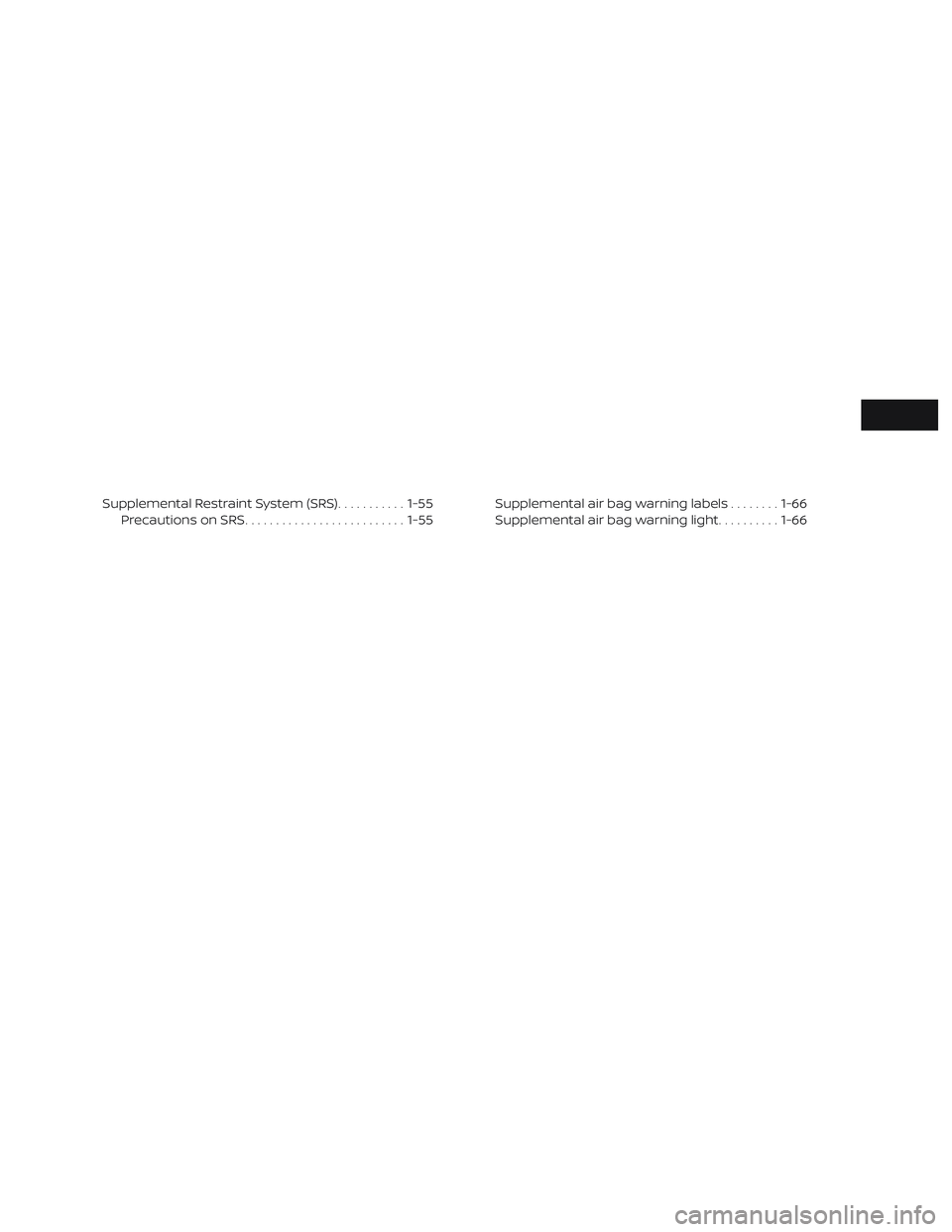
Supplemental Restraint System (SRS)...........1-55
Precautions on SRS .......................... 1-55Supplemental air bag warning labels
........1-66
Supplemental air bag warning light ..........1-66
Page 44 of 426
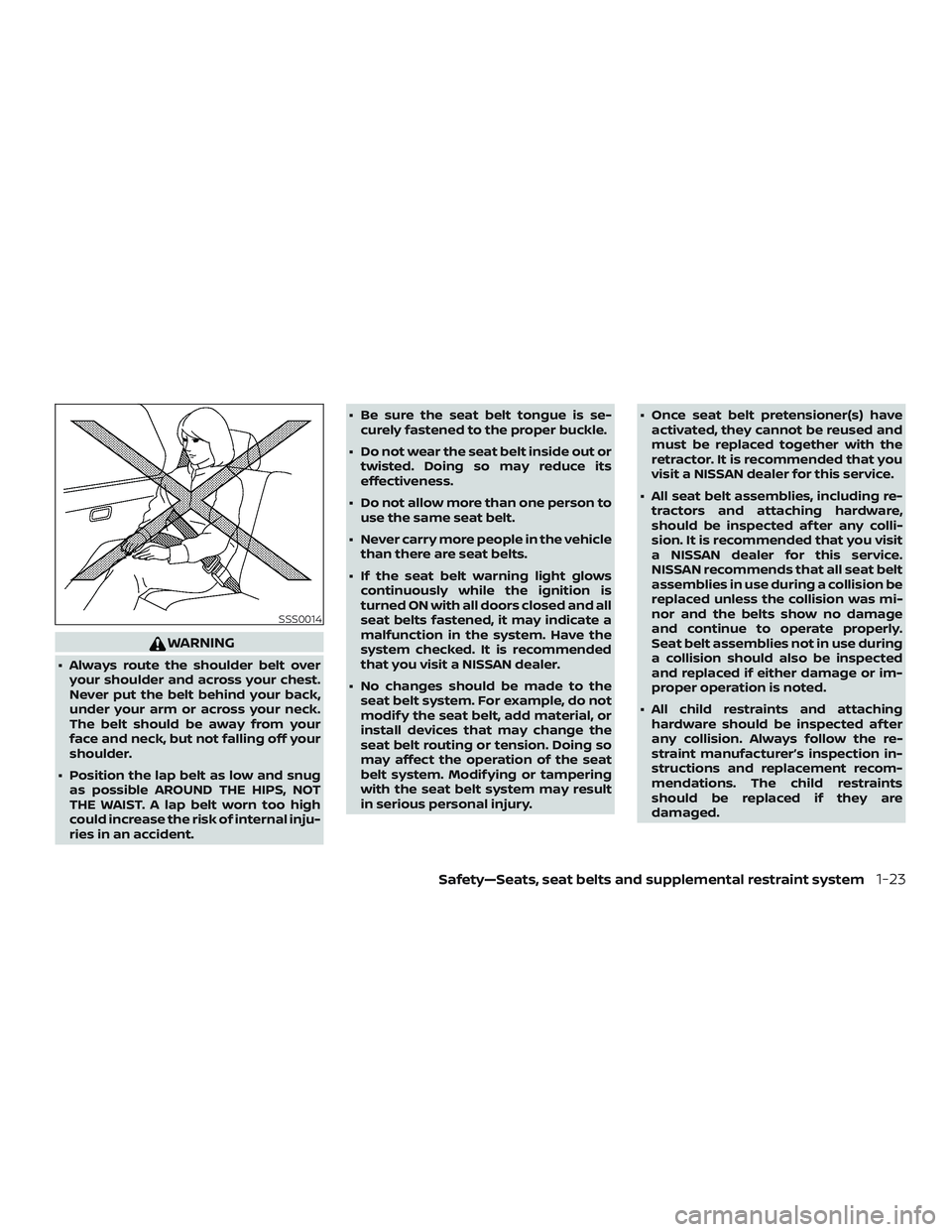
WARNING
∙ Always route the shoulder belt overyour shoulder and across your chest.
Never put the belt behind your back,
under your arm or across your neck.
The belt should be away from your
face and neck, but not falling off your
shoulder.
∙ Position the lap belt as low and snug as possible AROUND THE HIPS, NOT
THE WAIST. A lap belt worn too high
could increase the risk of internal inju-
ries in an accident. ∙ Be sure the seat belt tongue is se-
curely fastened to the proper buckle.
∙ Do not wear the seat belt inside out or twisted. Doing so may reduce its
effectiveness.
∙ Do not allow more than one person to use the same seat belt.
∙ Never carry more people in the vehicle than there are seat belts.
∙ If the seat belt warning light glows continuously while the ignition is
turned ON with all doors closed and all
seat belts fastened, it may indicate a
malfunction in the system. Have the
system checked. It is recommended
that you visit a NISSAN dealer.
∙ No changes should be made to the seat belt system. For example, do not
modif y the seat belt, add material, or
install devices that may change the
seat belt routing or tension. Doing so
may affect the operation of the seat
belt system. Modif ying or tampering
with the seat belt system may result
in serious personal injury. ∙ Once seat belt pretensioner(s) have
activated, they cannot be reused and
must be replaced together with the
retractor. It is recommended that you
visit a NISSAN dealer for this service.
∙ All seat belt assemblies, including re- tractors and attaching hardware,
should be inspected af ter any colli-
sion. It is recommended that you visit
a NISSAN dealer for this service.
NISSAN recommends that all seat belt
assemblies in use during a collision be
replaced unless the collision was mi-
nor and the belts show no damage
and continue to operate properly.
Seat belt assemblies not in use during
a collision should also be inspected
and replaced if either damage or im-
proper operation is noted.
∙ All child restraints and attaching hardware should be inspected af ter
any collision. Always follow the re-
straint manufacturer’s inspection in-
structions and replacement recom-
mendations. The child restraints
should be replaced if they are
damaged.
SSS0014
Safety—Seats, seat belts and supplemental restraint system1-23
Page 45 of 426
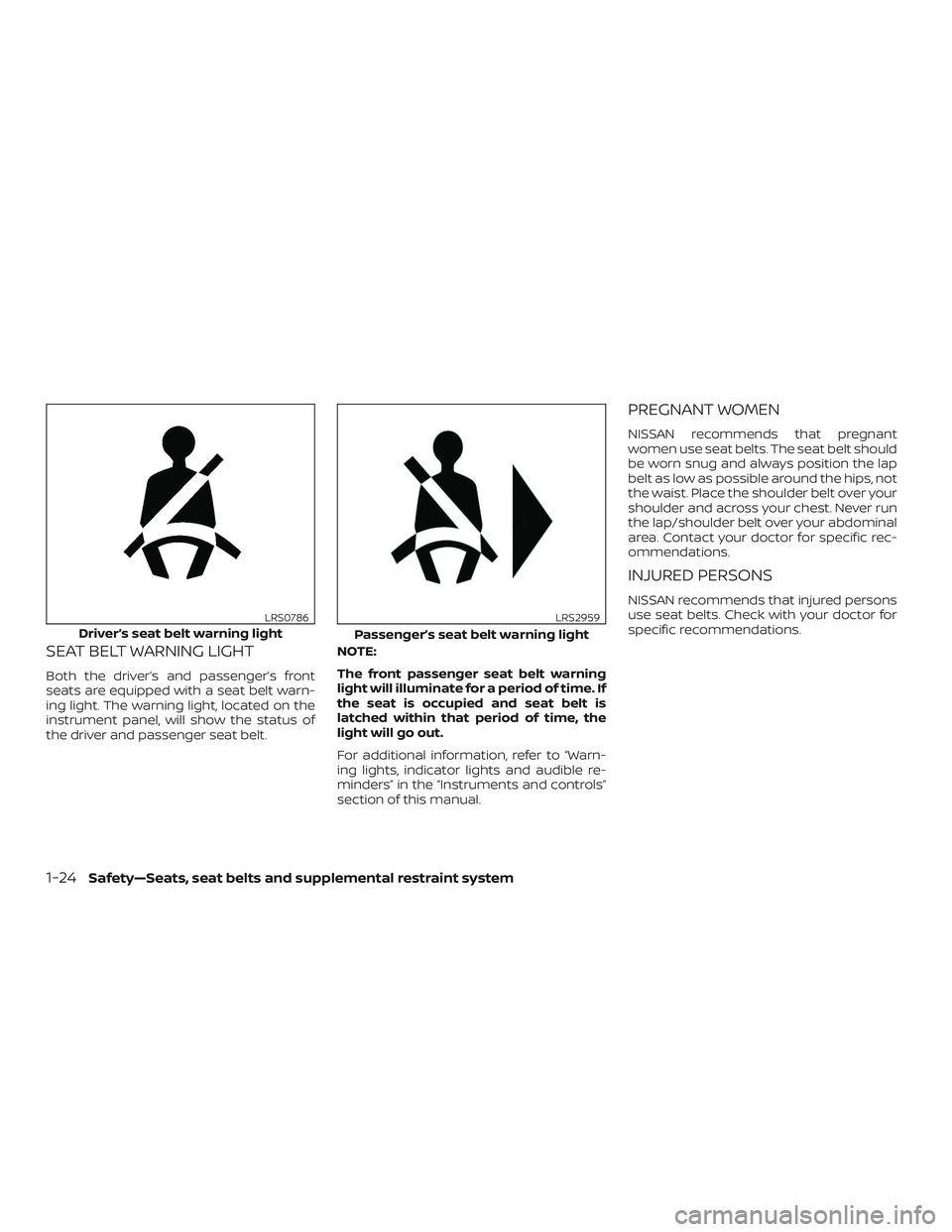
SEAT BELT WARNING LIGHT
Both the driver’s and passenger’s front
seats are equipped with a seat belt warn-
ing light. The warning light, located on the
instrument panel, will show the status of
the driver and passenger seat belt.NOTE:
The front passenger seat belt warning
light will illuminate for a period of time. If
the seat is occupied and seat belt is
latched within that period of time, the
light will go out.
For additional information, refer to “Warn-
ing lights, indicator lights and audible re-
minders” in the “Instruments and controls”
section of this manual.
PREGNANT WOMEN
NISSAN recommends that pregnant
women use seat belts. The seat belt should
be worn snug and always position the lap
belt as low as possible around the hips, not
the waist. Place the shoulder belt over your
shoulder and across your chest. Never run
the lap/shoulder belt over your abdominal
area. Contact your doctor for specific rec-
ommendations.
INJURED PERSONS
NISSAN recommends that injured persons
use seat belts. Check with your doctor for
specific recommendations.
Driver’s seat belt warning light
LRS0786
Passenger’s seat belt warning light
LRS2959
1-24Safety—Seats, seat belts and supplemental restraint system
Page 76 of 426
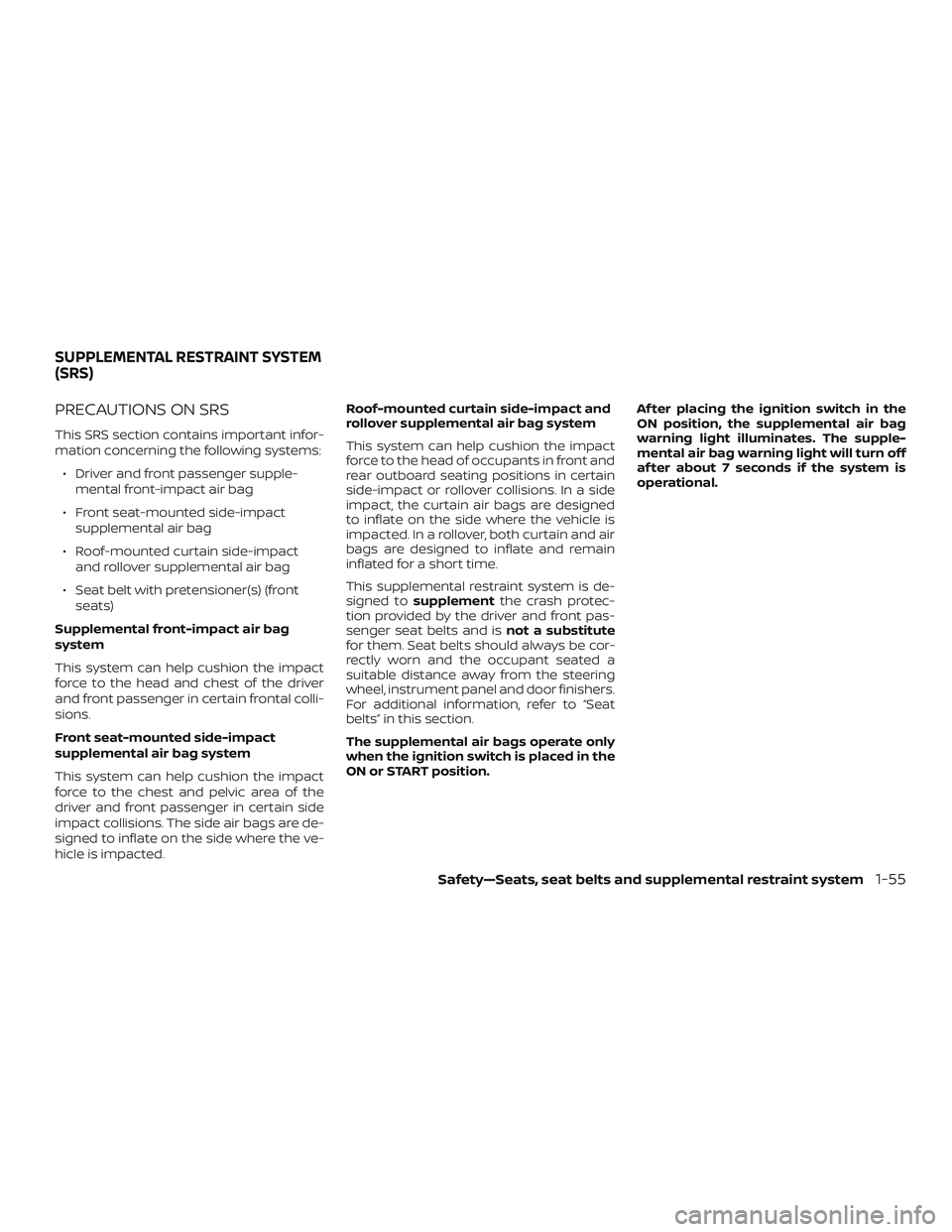
PRECAUTIONS ON SRS
This SRS section contains important infor-
mation concerning the following systems:∙ Driver and front passenger supple- mental front-impact air bag
∙ Front seat-mounted side-impact supplemental air bag
∙ Roof-mounted curtain side-impact and rollover supplemental air bag
∙ Seat belt with pretensioner(s) (front seats)
Supplemental front-impact air bag
system
This system can help cushion the impact
force to the head and chest of the driver
and front passenger in certain frontal colli-
sions.
Front seat-mounted side-impact
supplemental air bag system
This system can help cushion the impact
force to the chest and pelvic area of the
driver and front passenger in certain side
impact collisions. The side air bags are de-
signed to inflate on the side where the ve-
hicle is impacted. Roof-mounted curtain side-impact and
rollover supplemental air bag system
This system can help cushion the impact
force to the head of occupants in front and
rear outboard seating positions in certain
side-impact or rollover collisions. In a side
impact, the curtain air bags are designed
to inflate on the side where the vehicle is
impacted. In a rollover, both curtain and air
bags are designed to inflate and remain
inflated for a short time.
This supplemental restraint system is de-
signed to
supplement the crash protec-
tion provided by the driver and front pas-
senger seat belts and is not a substitute
for them. Seat belts should always be cor-
rectly worn and the occupant seated a
suitable distance away from the steering
wheel, instrument panel and door finishers.
For additional information, refer to “Seat
belts” in this section.
The supplemental air bags operate only
when the ignition switch is placed in the
ON or START position. Af ter placing the ignition switch in the
ON position, the supplemental air bag
warning light illuminates. The supple-
mental air bag warning light will turn off
af ter about 7 seconds if the system is
operational.
SUPPLEMENTAL RESTRAINT SYSTEM
(SRS)
Safety—Seats, seat belts and supplemental restraint system1-55
Page 83 of 426
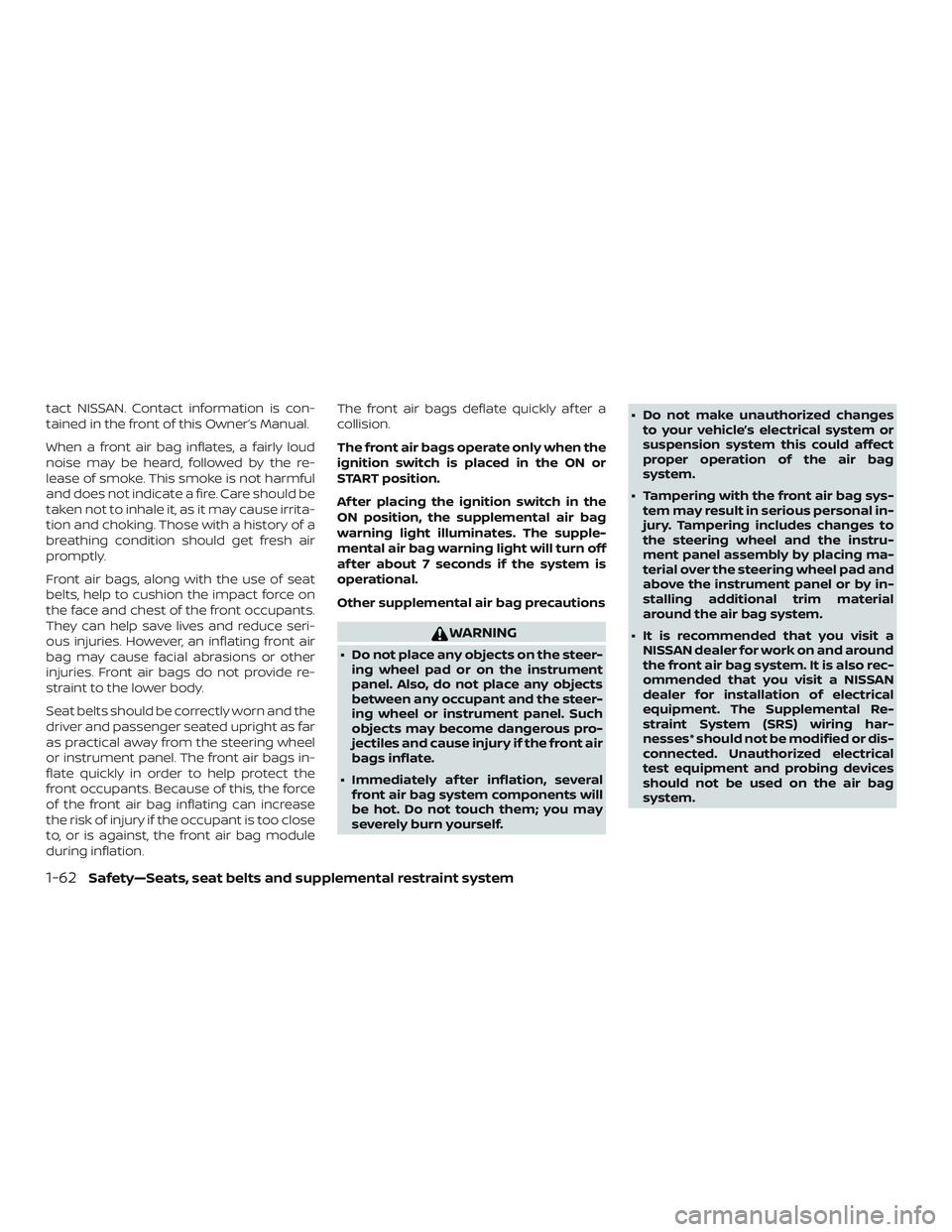
tact NISSAN. Contact information is con-
tained in the front of this Owner’s Manual.
When a front air bag inflates, a fairly loud
noise may be heard, followed by the re-
lease of smoke. This smoke is not harmful
and does not indicate a fire. Care should be
taken not to inhale it, as it may cause irrita-
tion and choking. Those with a history of a
breathing condition should get fresh air
promptly.
Front air bags, along with the use of seat
belts, help to cushion the impact force on
the face and chest of the front occupants.
They can help save lives and reduce seri-
ous injuries. However, an inflating front air
bag may cause facial abrasions or other
injuries. Front air bags do not provide re-
straint to the lower body.
Seat belts should be correctly worn and the
driver and passenger seated upright as far
as practical away from the steering wheel
or instrument panel. The front air bags in-
flate quickly in order to help protect the
front occupants. Because of this, the force
of the front air bag inflating can increase
the risk of injury if the occupant is too close
to, or is against, the front air bag module
during inflation.The front air bags deflate quickly af ter a
collision.
The front air bags operate only when the
ignition switch is placed in the ON or
START position.
Af ter placing the ignition switch in the
ON position, the supplemental air bag
warning light illuminates. The supple-
mental air bag warning light will turn off
af ter about 7 seconds if the system is
operational.
Other supplemental air bag precautions
WARNING
∙ Do not place any objects on the steer-
ing wheel pad or on the instrument
panel. Also, do not place any objects
between any occupant and the steer-
ing wheel or instrument panel. Such
objects may become dangerous pro-
jectiles and cause injury if the front air
bags inflate.
∙ Immediately af ter inflation, several front air bag system components will
be hot. Do not touch them; you may
severely burn yourself. ∙ Do not make unauthorized changes
to your vehicle’s electrical system or
suspension system this could affect
proper operation of the air bag
system.
∙ Tampering with the front air bag sys- tem may result in serious personal in-
jury. Tampering includes changes to
the steering wheel and the instru-
ment panel assembly by placing ma-
terial over the steering wheel pad and
above the instrument panel or by in-
stalling additional trim material
around the air bag system.
∙ It is recommended that you visit a NISSAN dealer for work on and around
the front air bag system. It is also rec-
ommended that you visit a NISSAN
dealer for installation of electrical
equipment. The Supplemental Re-
straint System (SRS) wiring har-
nesses* should not be modified or dis-
connected. Unauthorized electrical
test equipment and probing devices
should not be used on the air bag
system.
1-62Safety—Seats, seat belts and supplemental restraint system
Page 85 of 426
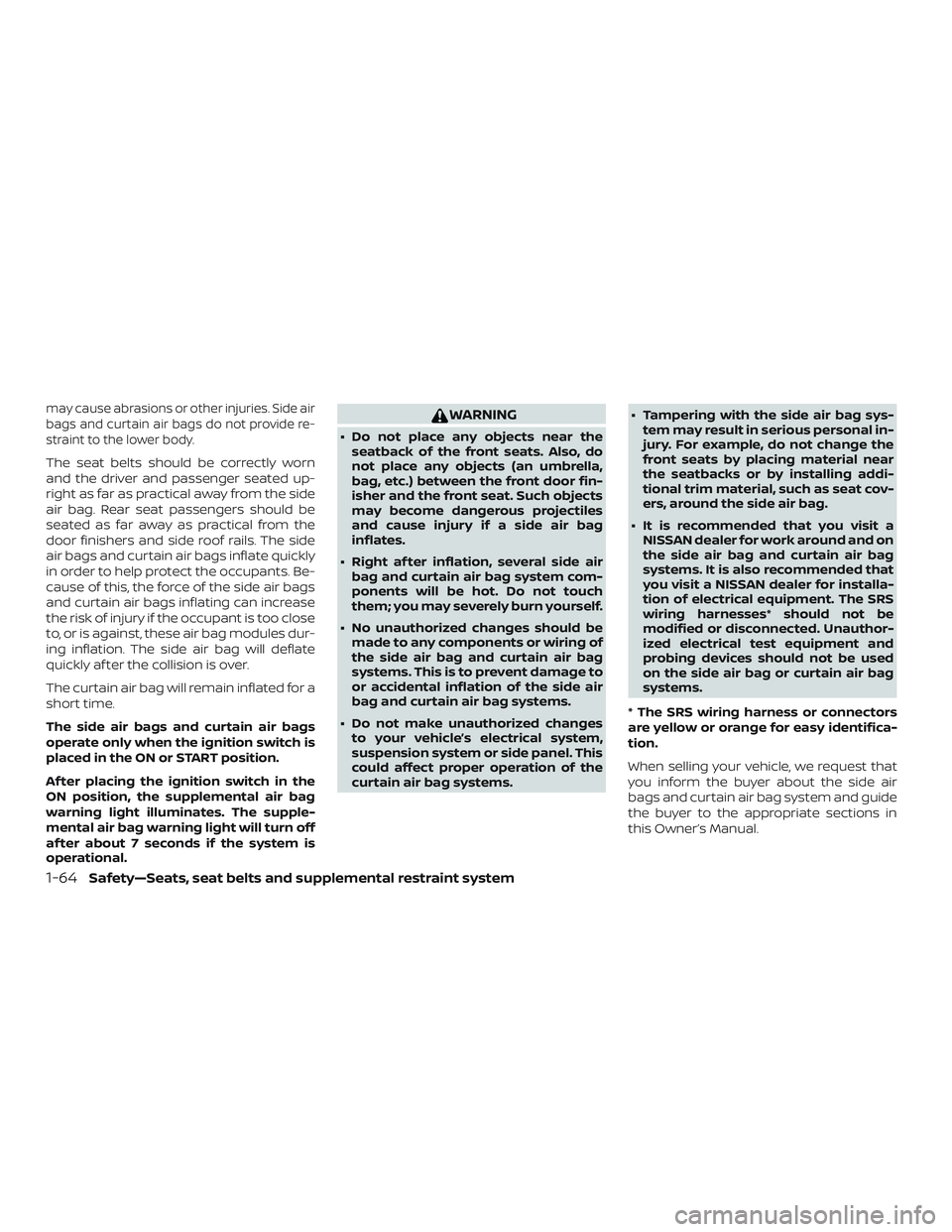
may cause abrasions or other injuries. Side air
bags and curtain air bags do not provide re-
straint to the lower body.
The seat belts should be correctly worn
and the driver and passenger seated up-
right as far as practical away from the side
air bag. Rear seat passengers should be
seated as far away as practical from the
door finishers and side roof rails. The side
air bags and curtain air bags inflate quickly
in order to help protect the occupants. Be-
cause of this, the force of the side air bags
and curtain air bags inflating can increase
the risk of injury if the occupant is too close
to, or is against, these air bag modules dur-
ing inflation. The side air bag will deflate
quickly af ter the collision is over.
The curtain air bag will remain inflated for a
short time.
The side air bags and curtain air bags
operate only when the ignition switch is
placed in the ON or START position.
Af ter placing the ignition switch in the
ON position, the supplemental air bag
warning light illuminates. The supple-
mental air bag warning light will turn off
af ter about 7 seconds if the system is
operational.
WARNING
∙ Do not place any objects near theseatback of the front seats. Also, do
not place any objects (an umbrella,
bag, etc.) between the front door fin-
isher and the front seat. Such objects
may become dangerous projectiles
and cause injury if a side air bag
inflates.
∙ Right af ter inflation, several side air bag and curtain air bag system com-
ponents will be hot. Do not touch
them; you may severely burn yourself.
∙ No unauthorized changes should be made to any components or wiring of
the side air bag and curtain air bag
systems. This is to prevent damage to
or accidental inflation of the side air
bag and curtain air bag systems.
∙ Do not make unauthorized changes to your vehicle’s electrical system,
suspension system or side panel. This
could affect proper operation of the
curtain air bag systems. ∙ Tampering with the side air bag sys-
tem may result in serious personal in-
jury. For example, do not change the
front seats by placing material near
the seatbacks or by installing addi-
tional trim material, such as seat cov-
ers, around the side air bag.
∙ It is recommended that you visit a NISSAN dealer for work around and on
the side air bag and curtain air bag
systems. It is also recommended that
you visit a NISSAN dealer for installa-
tion of electrical equipment. The SRS
wiring harnesses* should not be
modified or disconnected. Unauthor-
ized electrical test equipment and
probing devices should not be used
on the side air bag or curtain air bag
systems.
* The SRS wiring harness or connectors
are yellow or orange for easy identifica-
tion.
When selling your vehicle, we request that
you inform the buyer about the side air
bags and curtain air bag system and guide
the buyer to the appropriate sections in
this Owner’s Manual.
1-64Safety—Seats, seat belts and supplemental restraint system